Comprehensive Report: Cultural Diversity Management in the Workplace
VerifiedAdded on 2021/02/12
|8
|2907
|135
Report
AI Summary
This report examines the critical topic of cultural diversity management within organizations. It begins with an introduction highlighting the importance of diversity for workforce productivity, attracting talent, adapting to change, and competing in a globalized economy. The research aims to identify effective cultural diversity management strategies and analyze their impact on the workplace. The report outlines research objectives, including analyzing management practices, understanding challenges, evaluating impacts on employee and organizational performance, and emphasizing the importance of cultural diversity. The methodology section details the use of an interpretive research philosophy, a qualitative research strategy employing questionnaires, and an inductive research approach. The literature review explores workforce diversity, diversity management, and cultural diversity, emphasizing the role of training, open communication, and mentoring. The report also examines the impact of cultural diversity on workplace dynamics, including communication, cohesion, and conflict resolution. The report also mentions the importance of addressing unconscious bias and implementing diversity management approaches. The study utilizes primary and secondary data collection methods to gain relevant information and fulfill its objectives. The report concludes with a comprehensive reference list.
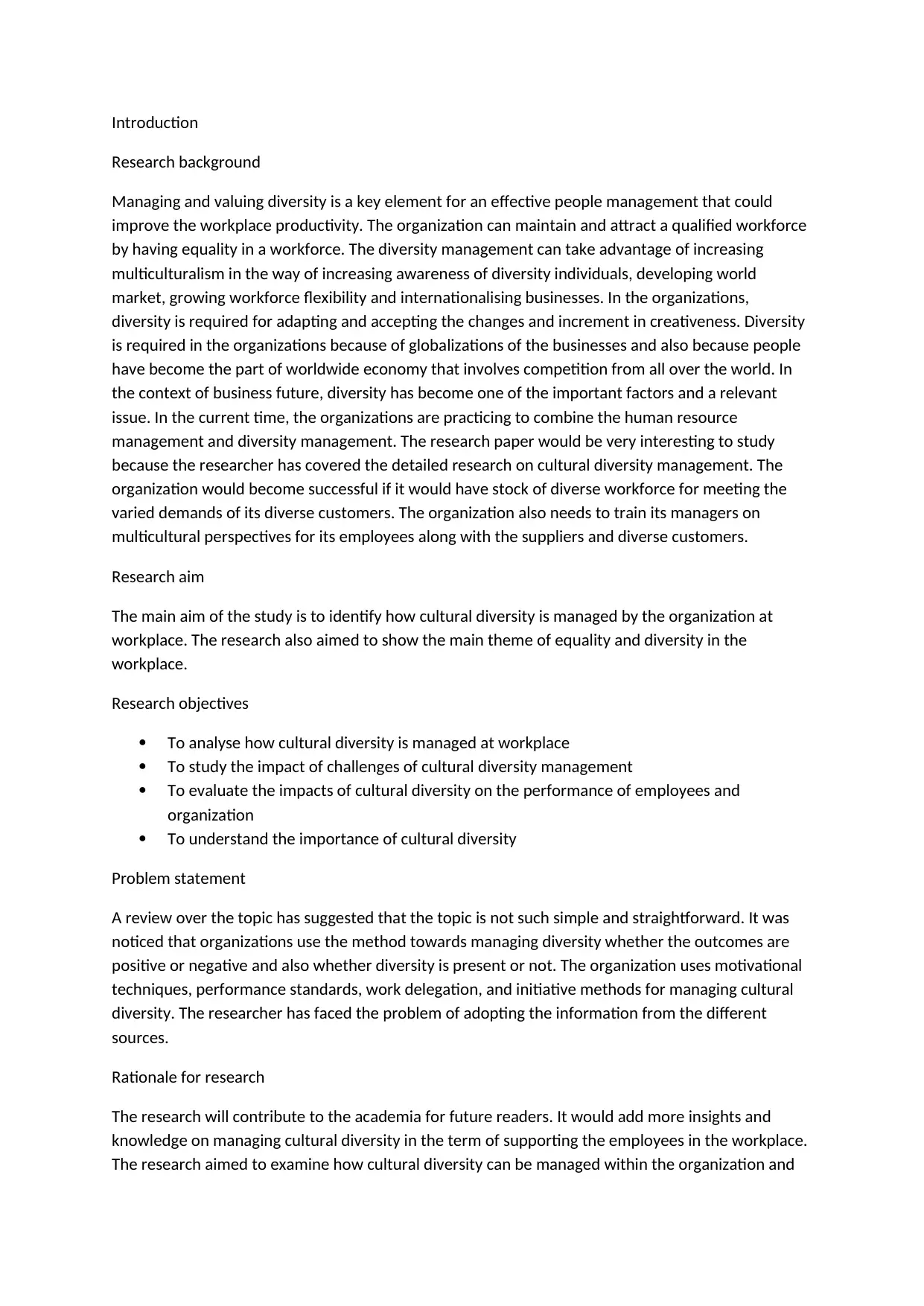
Introduction
Research background
Managing and valuing diversity is a key element for an effective people management that could
improve the workplace productivity. The organization can maintain and attract a qualified workforce
by having equality in a workforce. The diversity management can take advantage of increasing
multiculturalism in the way of increasing awareness of diversity individuals, developing world
market, growing workforce flexibility and internationalising businesses. In the organizations,
diversity is required for adapting and accepting the changes and increment in creativeness. Diversity
is required in the organizations because of globalizations of the businesses and also because people
have become the part of worldwide economy that involves competition from all over the world. In
the context of business future, diversity has become one of the important factors and a relevant
issue. In the current time, the organizations are practicing to combine the human resource
management and diversity management. The research paper would be very interesting to study
because the researcher has covered the detailed research on cultural diversity management. The
organization would become successful if it would have stock of diverse workforce for meeting the
varied demands of its diverse customers. The organization also needs to train its managers on
multicultural perspectives for its employees along with the suppliers and diverse customers.
Research aim
The main aim of the study is to identify how cultural diversity is managed by the organization at
workplace. The research also aimed to show the main theme of equality and diversity in the
workplace.
Research objectives
To analyse how cultural diversity is managed at workplace
To study the impact of challenges of cultural diversity management
To evaluate the impacts of cultural diversity on the performance of employees and
organization
To understand the importance of cultural diversity
Problem statement
A review over the topic has suggested that the topic is not such simple and straightforward. It was
noticed that organizations use the method towards managing diversity whether the outcomes are
positive or negative and also whether diversity is present or not. The organization uses motivational
techniques, performance standards, work delegation, and initiative methods for managing cultural
diversity. The researcher has faced the problem of adopting the information from the different
sources.
Rationale for research
The research will contribute to the academia for future readers. It would add more insights and
knowledge on managing cultural diversity in the term of supporting the employees in the workplace.
The research aimed to examine how cultural diversity can be managed within the organization and
Research background
Managing and valuing diversity is a key element for an effective people management that could
improve the workplace productivity. The organization can maintain and attract a qualified workforce
by having equality in a workforce. The diversity management can take advantage of increasing
multiculturalism in the way of increasing awareness of diversity individuals, developing world
market, growing workforce flexibility and internationalising businesses. In the organizations,
diversity is required for adapting and accepting the changes and increment in creativeness. Diversity
is required in the organizations because of globalizations of the businesses and also because people
have become the part of worldwide economy that involves competition from all over the world. In
the context of business future, diversity has become one of the important factors and a relevant
issue. In the current time, the organizations are practicing to combine the human resource
management and diversity management. The research paper would be very interesting to study
because the researcher has covered the detailed research on cultural diversity management. The
organization would become successful if it would have stock of diverse workforce for meeting the
varied demands of its diverse customers. The organization also needs to train its managers on
multicultural perspectives for its employees along with the suppliers and diverse customers.
Research aim
The main aim of the study is to identify how cultural diversity is managed by the organization at
workplace. The research also aimed to show the main theme of equality and diversity in the
workplace.
Research objectives
To analyse how cultural diversity is managed at workplace
To study the impact of challenges of cultural diversity management
To evaluate the impacts of cultural diversity on the performance of employees and
organization
To understand the importance of cultural diversity
Problem statement
A review over the topic has suggested that the topic is not such simple and straightforward. It was
noticed that organizations use the method towards managing diversity whether the outcomes are
positive or negative and also whether diversity is present or not. The organization uses motivational
techniques, performance standards, work delegation, and initiative methods for managing cultural
diversity. The researcher has faced the problem of adopting the information from the different
sources.
Rationale for research
The research will contribute to the academia for future readers. It would add more insights and
knowledge on managing cultural diversity in the term of supporting the employees in the workplace.
The research aimed to examine how cultural diversity can be managed within the organization and
Paraphrase This Document
Need a fresh take? Get an instant paraphrase of this document with our AI Paraphraser
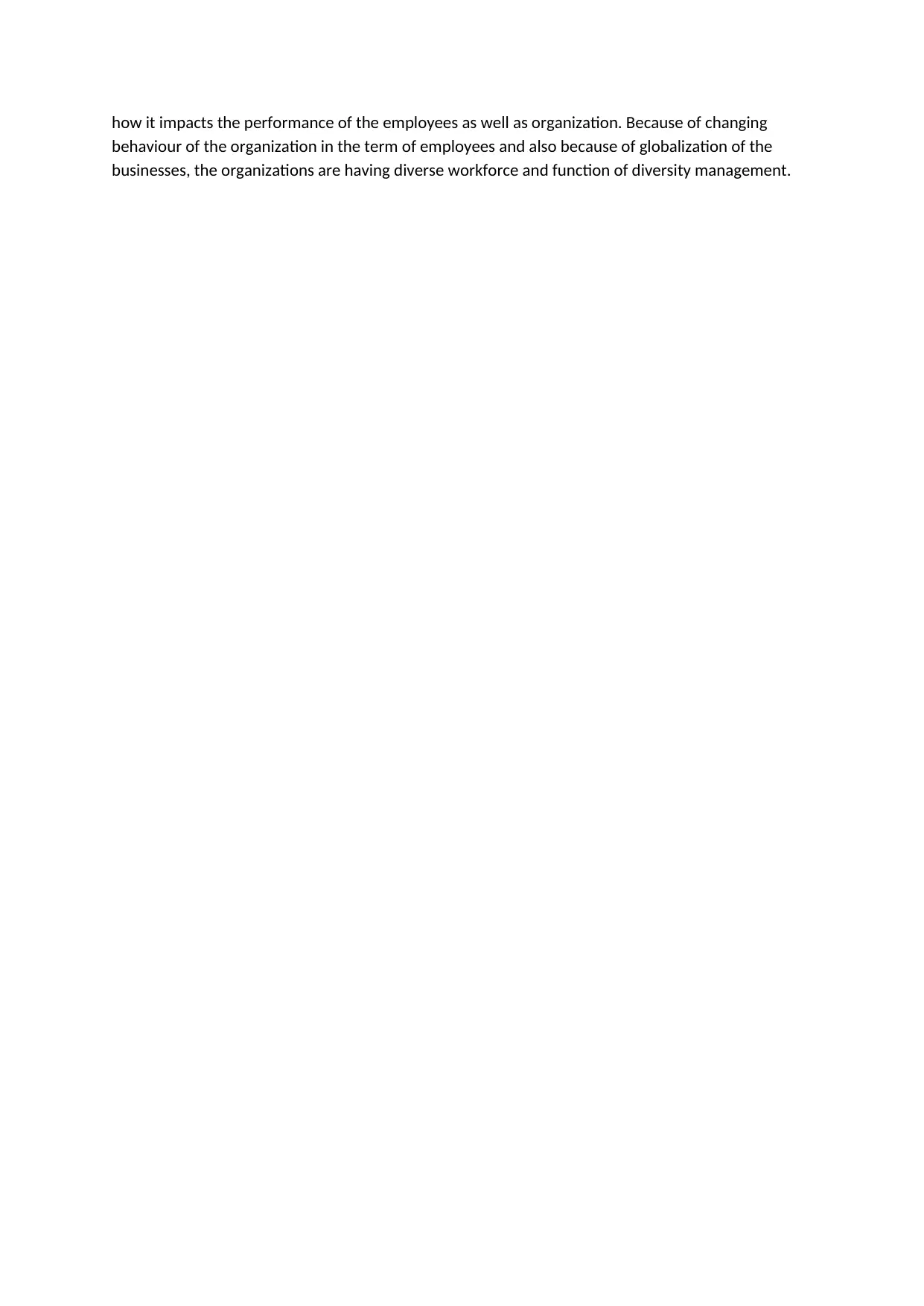
how it impacts the performance of the employees as well as organization. Because of changing
behaviour of the organization in the term of employees and also because of globalization of the
businesses, the organizations are having diverse workforce and function of diversity management.
behaviour of the organization in the term of employees and also because of globalization of the
businesses, the organizations are having diverse workforce and function of diversity management.

Managing cultural diversity in the workplace
Literature Review
The co-existence of employees from various socio-cultural backgrounds within the organization is
termed as workforce diversity. Xxxx defined the ways through which people differ and that could
also impact the relationship and tasks within the organization in the way of culture, religion,
education and race is known as diversity management. The organizations can be destroyed or can
achieve a competitive advantage if it can manage workforce diversity. Xxxx found that the unique
sets of behaviour, customs, symbols, language, expectations, attitudes, beliefs and values, which are
possessed by an individual in the way of sharing common characteristics with others is termed as
cultural diversity. Cultural diversity is not only the responsibility of the management level of the
organization but it is also the responsibility of every member that is connected with the
organization. Cultural diversity could become the reason of conflict it ignored by the organization
and also could be the reason for competitive advantage if cared properly and accepted by the
organization.
Promoting, training, and recruiting culturally diverse employees are the most important function of
the organizations in the current time. The different HRM approaches recognize the relationship
between the organization and culturally diverse people. The presence of variety in an association
additionally implies that the foundation is socially capable and gives equivalent occasion to the
gatherings without separation. Focal points of diversity management at a work environment include
increment in labour turnover and non-attendance and representatives who consider them to be
esteemed at the work environment. It is preferences of variety the board at a work environment
include increment in labour turnover and non-attendance and representatives who consider them to
be esteemed at the work environment. xxxxx uncovered that a culturally diverse group that has
been cooperating for a more extended period, is more viable in the association cycle and
employment execution.
Consolidating various societies at a working environment can bring about representatives thinking
that it is hard to show up at arrangements, which thusly can prompt social conflicts and negative
elements. The association needs to actualize the variety of arrangements at any expense. It's implied
that in the starting, the representative dislike or consent to the equivalent. Limiting representatives'
capacities and inspiration happens because of negative treatment of the labourers, which thusly
brings about lower work execution. This circumstance happens when botch of variety creates at the
working environment. A differing climate can likewise prompt absence of acknowledgement,
because of hostile remarks or bias sentiments, which thus makes negative elements at the work
environment. A diverse environment, particularly with regards to race, may lead to a few issues, for
example, interchanges breakdown and low cohesion.
Cultural diversity can be managed by different ways that must be practised in organizations like
open communication is one of the most beneficial ways to manage cultural diversity. Training and
educating the employees regarding cultural diversity would also lead to manage cultural diversity in
the workplace. For decreasing discrimination, providing the mentors is the best way and this would
help in managing the cultural diversity at the workplace. This could also be achieved by making the
managers more accountable in the way of including diverse accountability in the job of the
managers for intensifying their actions for the diverse workforce. Xxxxx found that cultural diversity
Literature Review
The co-existence of employees from various socio-cultural backgrounds within the organization is
termed as workforce diversity. Xxxx defined the ways through which people differ and that could
also impact the relationship and tasks within the organization in the way of culture, religion,
education and race is known as diversity management. The organizations can be destroyed or can
achieve a competitive advantage if it can manage workforce diversity. Xxxx found that the unique
sets of behaviour, customs, symbols, language, expectations, attitudes, beliefs and values, which are
possessed by an individual in the way of sharing common characteristics with others is termed as
cultural diversity. Cultural diversity is not only the responsibility of the management level of the
organization but it is also the responsibility of every member that is connected with the
organization. Cultural diversity could become the reason of conflict it ignored by the organization
and also could be the reason for competitive advantage if cared properly and accepted by the
organization.
Promoting, training, and recruiting culturally diverse employees are the most important function of
the organizations in the current time. The different HRM approaches recognize the relationship
between the organization and culturally diverse people. The presence of variety in an association
additionally implies that the foundation is socially capable and gives equivalent occasion to the
gatherings without separation. Focal points of diversity management at a work environment include
increment in labour turnover and non-attendance and representatives who consider them to be
esteemed at the work environment. It is preferences of variety the board at a work environment
include increment in labour turnover and non-attendance and representatives who consider them to
be esteemed at the work environment. xxxxx uncovered that a culturally diverse group that has
been cooperating for a more extended period, is more viable in the association cycle and
employment execution.
Consolidating various societies at a working environment can bring about representatives thinking
that it is hard to show up at arrangements, which thusly can prompt social conflicts and negative
elements. The association needs to actualize the variety of arrangements at any expense. It's implied
that in the starting, the representative dislike or consent to the equivalent. Limiting representatives'
capacities and inspiration happens because of negative treatment of the labourers, which thusly
brings about lower work execution. This circumstance happens when botch of variety creates at the
working environment. A differing climate can likewise prompt absence of acknowledgement,
because of hostile remarks or bias sentiments, which thus makes negative elements at the work
environment. A diverse environment, particularly with regards to race, may lead to a few issues, for
example, interchanges breakdown and low cohesion.
Cultural diversity can be managed by different ways that must be practised in organizations like
open communication is one of the most beneficial ways to manage cultural diversity. Training and
educating the employees regarding cultural diversity would also lead to manage cultural diversity in
the workplace. For decreasing discrimination, providing the mentors is the best way and this would
help in managing the cultural diversity at the workplace. This could also be achieved by making the
managers more accountable in the way of including diverse accountability in the job of the
managers for intensifying their actions for the diverse workforce. Xxxxx found that cultural diversity
⊘ This is a preview!⊘
Do you want full access?
Subscribe today to unlock all pages.

Trusted by 1+ million students worldwide
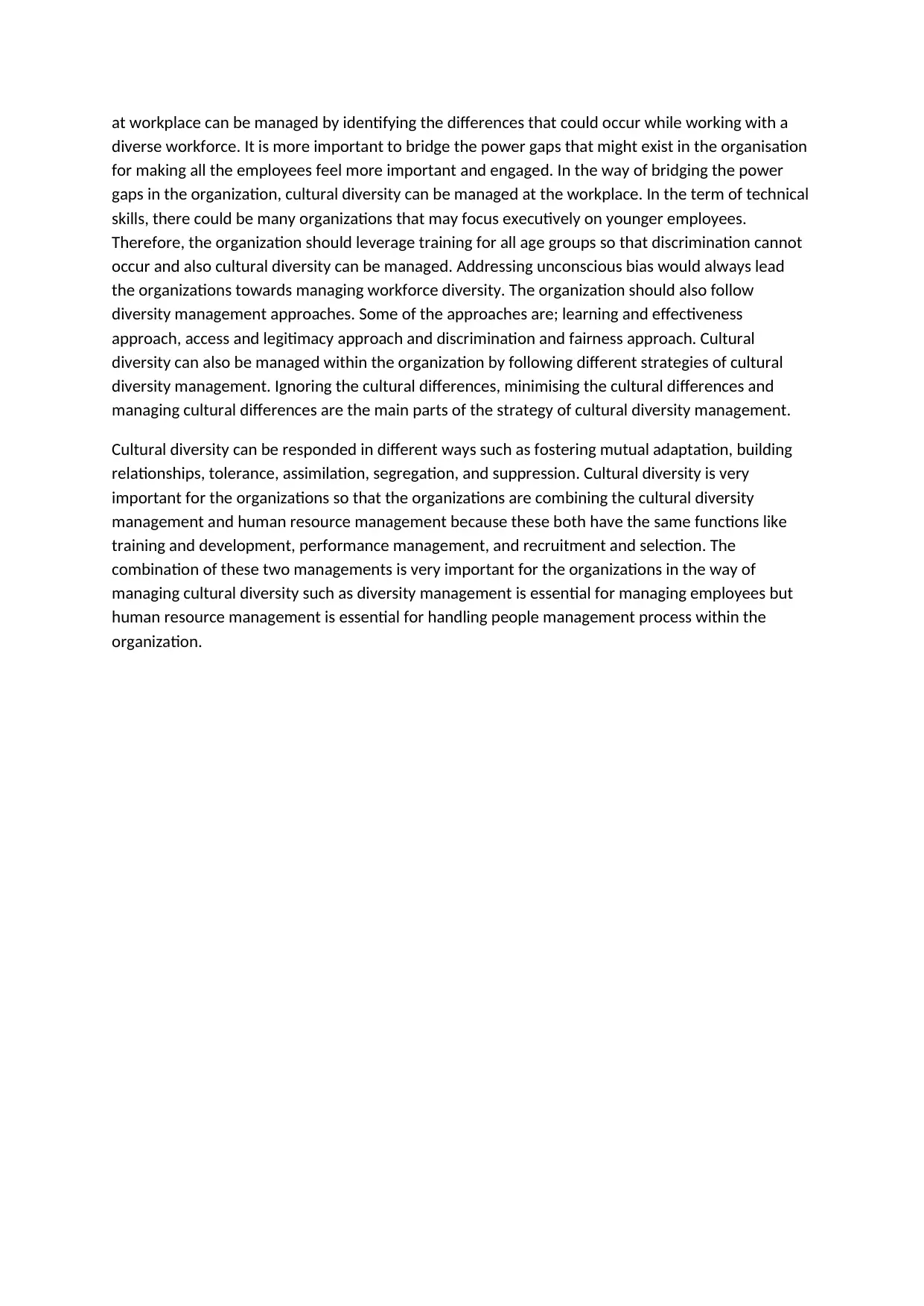
at workplace can be managed by identifying the differences that could occur while working with a
diverse workforce. It is more important to bridge the power gaps that might exist in the organisation
for making all the employees feel more important and engaged. In the way of bridging the power
gaps in the organization, cultural diversity can be managed at the workplace. In the term of technical
skills, there could be many organizations that may focus executively on younger employees.
Therefore, the organization should leverage training for all age groups so that discrimination cannot
occur and also cultural diversity can be managed. Addressing unconscious bias would always lead
the organizations towards managing workforce diversity. The organization should also follow
diversity management approaches. Some of the approaches are; learning and effectiveness
approach, access and legitimacy approach and discrimination and fairness approach. Cultural
diversity can also be managed within the organization by following different strategies of cultural
diversity management. Ignoring the cultural differences, minimising the cultural differences and
managing cultural differences are the main parts of the strategy of cultural diversity management.
Cultural diversity can be responded in different ways such as fostering mutual adaptation, building
relationships, tolerance, assimilation, segregation, and suppression. Cultural diversity is very
important for the organizations so that the organizations are combining the cultural diversity
management and human resource management because these both have the same functions like
training and development, performance management, and recruitment and selection. The
combination of these two managements is very important for the organizations in the way of
managing cultural diversity such as diversity management is essential for managing employees but
human resource management is essential for handling people management process within the
organization.
diverse workforce. It is more important to bridge the power gaps that might exist in the organisation
for making all the employees feel more important and engaged. In the way of bridging the power
gaps in the organization, cultural diversity can be managed at the workplace. In the term of technical
skills, there could be many organizations that may focus executively on younger employees.
Therefore, the organization should leverage training for all age groups so that discrimination cannot
occur and also cultural diversity can be managed. Addressing unconscious bias would always lead
the organizations towards managing workforce diversity. The organization should also follow
diversity management approaches. Some of the approaches are; learning and effectiveness
approach, access and legitimacy approach and discrimination and fairness approach. Cultural
diversity can also be managed within the organization by following different strategies of cultural
diversity management. Ignoring the cultural differences, minimising the cultural differences and
managing cultural differences are the main parts of the strategy of cultural diversity management.
Cultural diversity can be responded in different ways such as fostering mutual adaptation, building
relationships, tolerance, assimilation, segregation, and suppression. Cultural diversity is very
important for the organizations so that the organizations are combining the cultural diversity
management and human resource management because these both have the same functions like
training and development, performance management, and recruitment and selection. The
combination of these two managements is very important for the organizations in the way of
managing cultural diversity such as diversity management is essential for managing employees but
human resource management is essential for handling people management process within the
organization.
Paraphrase This Document
Need a fresh take? Get an instant paraphrase of this document with our AI Paraphraser
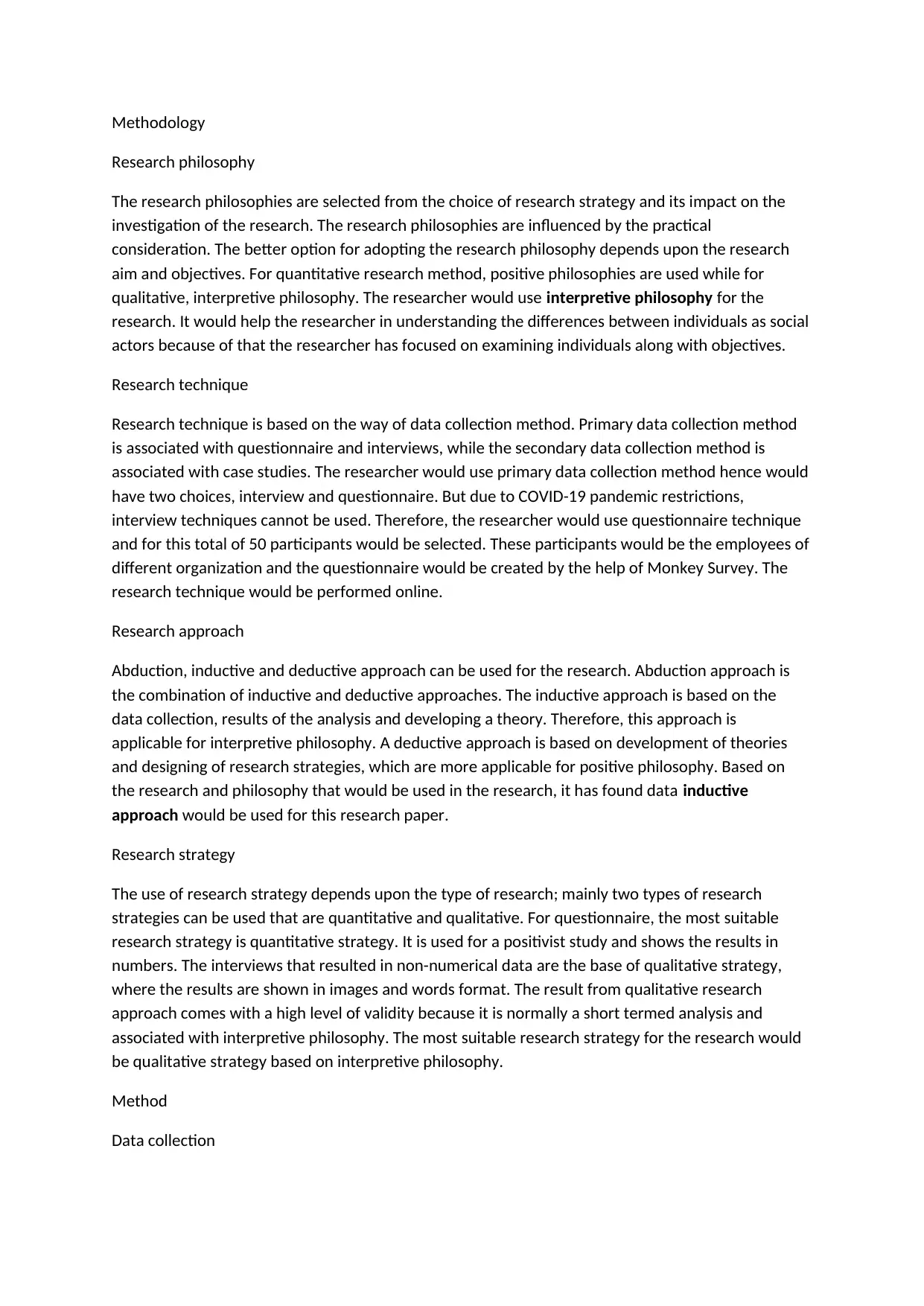
Methodology
Research philosophy
The research philosophies are selected from the choice of research strategy and its impact on the
investigation of the research. The research philosophies are influenced by the practical
consideration. The better option for adopting the research philosophy depends upon the research
aim and objectives. For quantitative research method, positive philosophies are used while for
qualitative, interpretive philosophy. The researcher would use interpretive philosophy for the
research. It would help the researcher in understanding the differences between individuals as social
actors because of that the researcher has focused on examining individuals along with objectives.
Research technique
Research technique is based on the way of data collection method. Primary data collection method
is associated with questionnaire and interviews, while the secondary data collection method is
associated with case studies. The researcher would use primary data collection method hence would
have two choices, interview and questionnaire. But due to COVID-19 pandemic restrictions,
interview techniques cannot be used. Therefore, the researcher would use questionnaire technique
and for this total of 50 participants would be selected. These participants would be the employees of
different organization and the questionnaire would be created by the help of Monkey Survey. The
research technique would be performed online.
Research approach
Abduction, inductive and deductive approach can be used for the research. Abduction approach is
the combination of inductive and deductive approaches. The inductive approach is based on the
data collection, results of the analysis and developing a theory. Therefore, this approach is
applicable for interpretive philosophy. A deductive approach is based on development of theories
and designing of research strategies, which are more applicable for positive philosophy. Based on
the research and philosophy that would be used in the research, it has found data inductive
approach would be used for this research paper.
Research strategy
The use of research strategy depends upon the type of research; mainly two types of research
strategies can be used that are quantitative and qualitative. For questionnaire, the most suitable
research strategy is quantitative strategy. It is used for a positivist study and shows the results in
numbers. The interviews that resulted in non-numerical data are the base of qualitative strategy,
where the results are shown in images and words format. The result from qualitative research
approach comes with a high level of validity because it is normally a short termed analysis and
associated with interpretive philosophy. The most suitable research strategy for the research would
be qualitative strategy based on interpretive philosophy.
Method
Data collection
Research philosophy
The research philosophies are selected from the choice of research strategy and its impact on the
investigation of the research. The research philosophies are influenced by the practical
consideration. The better option for adopting the research philosophy depends upon the research
aim and objectives. For quantitative research method, positive philosophies are used while for
qualitative, interpretive philosophy. The researcher would use interpretive philosophy for the
research. It would help the researcher in understanding the differences between individuals as social
actors because of that the researcher has focused on examining individuals along with objectives.
Research technique
Research technique is based on the way of data collection method. Primary data collection method
is associated with questionnaire and interviews, while the secondary data collection method is
associated with case studies. The researcher would use primary data collection method hence would
have two choices, interview and questionnaire. But due to COVID-19 pandemic restrictions,
interview techniques cannot be used. Therefore, the researcher would use questionnaire technique
and for this total of 50 participants would be selected. These participants would be the employees of
different organization and the questionnaire would be created by the help of Monkey Survey. The
research technique would be performed online.
Research approach
Abduction, inductive and deductive approach can be used for the research. Abduction approach is
the combination of inductive and deductive approaches. The inductive approach is based on the
data collection, results of the analysis and developing a theory. Therefore, this approach is
applicable for interpretive philosophy. A deductive approach is based on development of theories
and designing of research strategies, which are more applicable for positive philosophy. Based on
the research and philosophy that would be used in the research, it has found data inductive
approach would be used for this research paper.
Research strategy
The use of research strategy depends upon the type of research; mainly two types of research
strategies can be used that are quantitative and qualitative. For questionnaire, the most suitable
research strategy is quantitative strategy. It is used for a positivist study and shows the results in
numbers. The interviews that resulted in non-numerical data are the base of qualitative strategy,
where the results are shown in images and words format. The result from qualitative research
approach comes with a high level of validity because it is normally a short termed analysis and
associated with interpretive philosophy. The most suitable research strategy for the research would
be qualitative strategy based on interpretive philosophy.
Method
Data collection
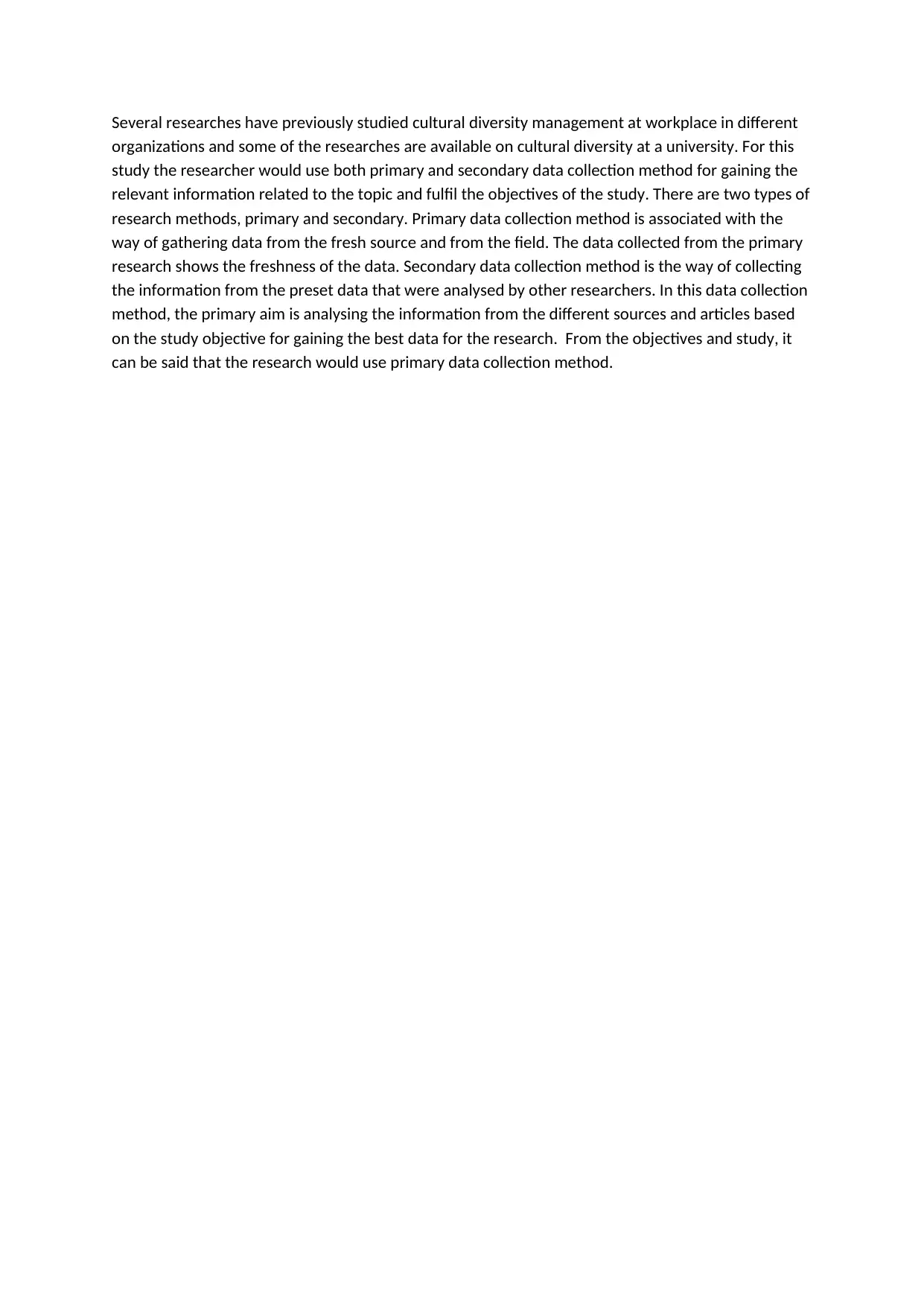
Several researches have previously studied cultural diversity management at workplace in different
organizations and some of the researches are available on cultural diversity at a university. For this
study the researcher would use both primary and secondary data collection method for gaining the
relevant information related to the topic and fulfil the objectives of the study. There are two types of
research methods, primary and secondary. Primary data collection method is associated with the
way of gathering data from the fresh source and from the field. The data collected from the primary
research shows the freshness of the data. Secondary data collection method is the way of collecting
the information from the preset data that were analysed by other researchers. In this data collection
method, the primary aim is analysing the information from the different sources and articles based
on the study objective for gaining the best data for the research. From the objectives and study, it
can be said that the research would use primary data collection method.
organizations and some of the researches are available on cultural diversity at a university. For this
study the researcher would use both primary and secondary data collection method for gaining the
relevant information related to the topic and fulfil the objectives of the study. There are two types of
research methods, primary and secondary. Primary data collection method is associated with the
way of gathering data from the fresh source and from the field. The data collected from the primary
research shows the freshness of the data. Secondary data collection method is the way of collecting
the information from the preset data that were analysed by other researchers. In this data collection
method, the primary aim is analysing the information from the different sources and articles based
on the study objective for gaining the best data for the research. From the objectives and study, it
can be said that the research would use primary data collection method.
⊘ This is a preview!⊘
Do you want full access?
Subscribe today to unlock all pages.

Trusted by 1+ million students worldwide
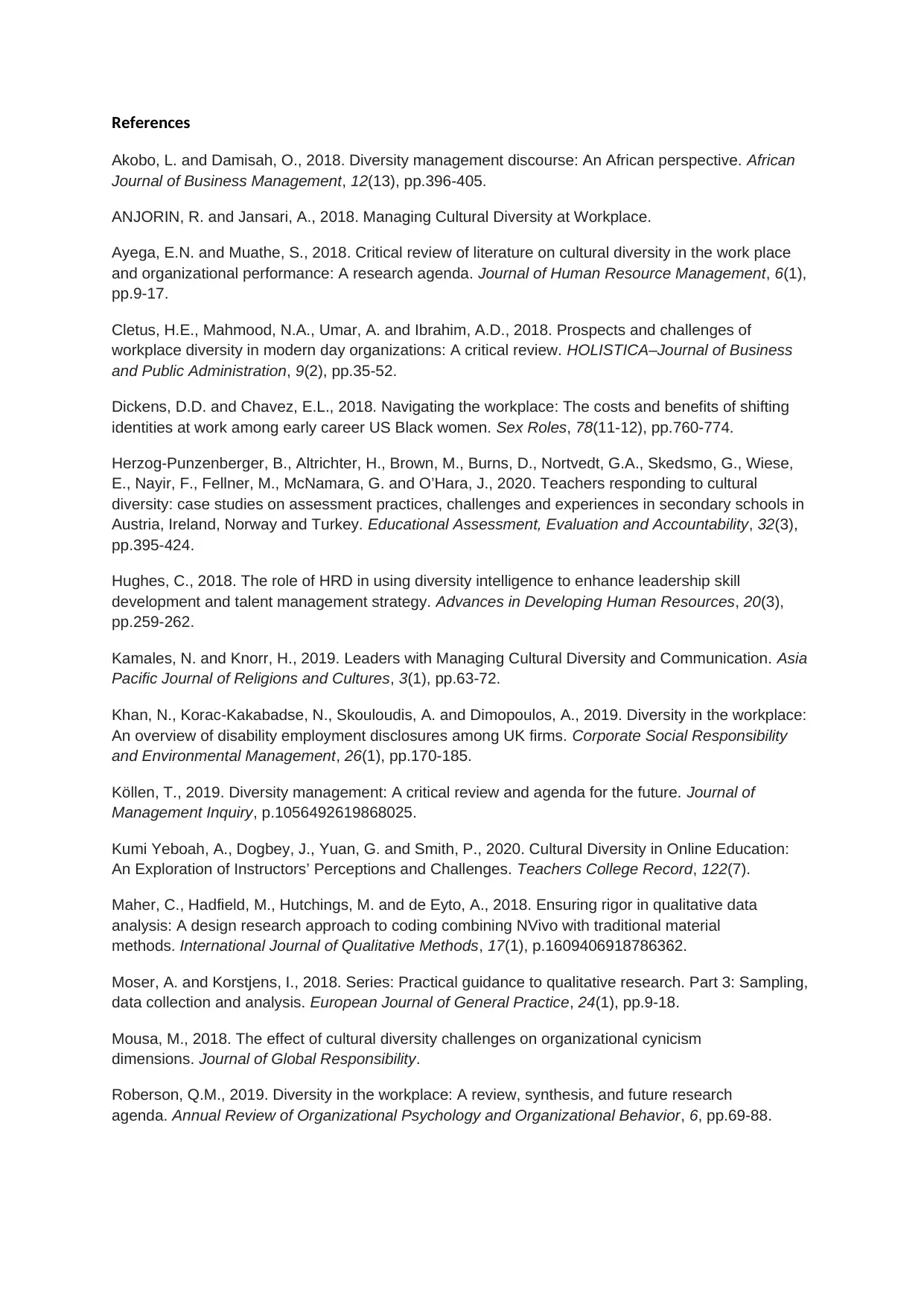
References
Akobo, L. and Damisah, O., 2018. Diversity management discourse: An African perspective. African
Journal of Business Management, 12(13), pp.396-405.
ANJORIN, R. and Jansari, A., 2018. Managing Cultural Diversity at Workplace.
Ayega, E.N. and Muathe, S., 2018. Critical review of literature on cultural diversity in the work place
and organizational performance: A research agenda. Journal of Human Resource Management, 6(1),
pp.9-17.
Cletus, H.E., Mahmood, N.A., Umar, A. and Ibrahim, A.D., 2018. Prospects and challenges of
workplace diversity in modern day organizations: A critical review. HOLISTICA–Journal of Business
and Public Administration, 9(2), pp.35-52.
Dickens, D.D. and Chavez, E.L., 2018. Navigating the workplace: The costs and benefits of shifting
identities at work among early career US Black women. Sex Roles, 78(11-12), pp.760-774.
Herzog-Punzenberger, B., Altrichter, H., Brown, M., Burns, D., Nortvedt, G.A., Skedsmo, G., Wiese,
E., Nayir, F., Fellner, M., McNamara, G. and O’Hara, J., 2020. Teachers responding to cultural
diversity: case studies on assessment practices, challenges and experiences in secondary schools in
Austria, Ireland, Norway and Turkey. Educational Assessment, Evaluation and Accountability, 32(3),
pp.395-424.
Hughes, C., 2018. The role of HRD in using diversity intelligence to enhance leadership skill
development and talent management strategy. Advances in Developing Human Resources, 20(3),
pp.259-262.
Kamales, N. and Knorr, H., 2019. Leaders with Managing Cultural Diversity and Communication. Asia
Pacific Journal of Religions and Cultures, 3(1), pp.63-72.
Khan, N., Korac‐Kakabadse, N., Skouloudis, A. and Dimopoulos, A., 2019. Diversity in the workplace:
An overview of disability employment disclosures among UK firms. Corporate Social Responsibility
and Environmental Management, 26(1), pp.170-185.
Köllen, T., 2019. Diversity management: A critical review and agenda for the future. Journal of
Management Inquiry, p.1056492619868025.
Kumi Yeboah, A., Dogbey, J., Yuan, G. and Smith, P., 2020. Cultural Diversity in Online Education:
An Exploration of Instructors’ Perceptions and Challenges. Teachers College Record, 122(7).
Maher, C., Hadfield, M., Hutchings, M. and de Eyto, A., 2018. Ensuring rigor in qualitative data
analysis: A design research approach to coding combining NVivo with traditional material
methods. International Journal of Qualitative Methods, 17(1), p.1609406918786362.
Moser, A. and Korstjens, I., 2018. Series: Practical guidance to qualitative research. Part 3: Sampling,
data collection and analysis. European Journal of General Practice, 24(1), pp.9-18.
Mousa, M., 2018. The effect of cultural diversity challenges on organizational cynicism
dimensions. Journal of Global Responsibility.
Roberson, Q.M., 2019. Diversity in the workplace: A review, synthesis, and future research
agenda. Annual Review of Organizational Psychology and Organizational Behavior, 6, pp.69-88.
Akobo, L. and Damisah, O., 2018. Diversity management discourse: An African perspective. African
Journal of Business Management, 12(13), pp.396-405.
ANJORIN, R. and Jansari, A., 2018. Managing Cultural Diversity at Workplace.
Ayega, E.N. and Muathe, S., 2018. Critical review of literature on cultural diversity in the work place
and organizational performance: A research agenda. Journal of Human Resource Management, 6(1),
pp.9-17.
Cletus, H.E., Mahmood, N.A., Umar, A. and Ibrahim, A.D., 2018. Prospects and challenges of
workplace diversity in modern day organizations: A critical review. HOLISTICA–Journal of Business
and Public Administration, 9(2), pp.35-52.
Dickens, D.D. and Chavez, E.L., 2018. Navigating the workplace: The costs and benefits of shifting
identities at work among early career US Black women. Sex Roles, 78(11-12), pp.760-774.
Herzog-Punzenberger, B., Altrichter, H., Brown, M., Burns, D., Nortvedt, G.A., Skedsmo, G., Wiese,
E., Nayir, F., Fellner, M., McNamara, G. and O’Hara, J., 2020. Teachers responding to cultural
diversity: case studies on assessment practices, challenges and experiences in secondary schools in
Austria, Ireland, Norway and Turkey. Educational Assessment, Evaluation and Accountability, 32(3),
pp.395-424.
Hughes, C., 2018. The role of HRD in using diversity intelligence to enhance leadership skill
development and talent management strategy. Advances in Developing Human Resources, 20(3),
pp.259-262.
Kamales, N. and Knorr, H., 2019. Leaders with Managing Cultural Diversity and Communication. Asia
Pacific Journal of Religions and Cultures, 3(1), pp.63-72.
Khan, N., Korac‐Kakabadse, N., Skouloudis, A. and Dimopoulos, A., 2019. Diversity in the workplace:
An overview of disability employment disclosures among UK firms. Corporate Social Responsibility
and Environmental Management, 26(1), pp.170-185.
Köllen, T., 2019. Diversity management: A critical review and agenda for the future. Journal of
Management Inquiry, p.1056492619868025.
Kumi Yeboah, A., Dogbey, J., Yuan, G. and Smith, P., 2020. Cultural Diversity in Online Education:
An Exploration of Instructors’ Perceptions and Challenges. Teachers College Record, 122(7).
Maher, C., Hadfield, M., Hutchings, M. and de Eyto, A., 2018. Ensuring rigor in qualitative data
analysis: A design research approach to coding combining NVivo with traditional material
methods. International Journal of Qualitative Methods, 17(1), p.1609406918786362.
Moser, A. and Korstjens, I., 2018. Series: Practical guidance to qualitative research. Part 3: Sampling,
data collection and analysis. European Journal of General Practice, 24(1), pp.9-18.
Mousa, M., 2018. The effect of cultural diversity challenges on organizational cynicism
dimensions. Journal of Global Responsibility.
Roberson, Q.M., 2019. Diversity in the workplace: A review, synthesis, and future research
agenda. Annual Review of Organizational Psychology and Organizational Behavior, 6, pp.69-88.
Paraphrase This Document
Need a fresh take? Get an instant paraphrase of this document with our AI Paraphraser
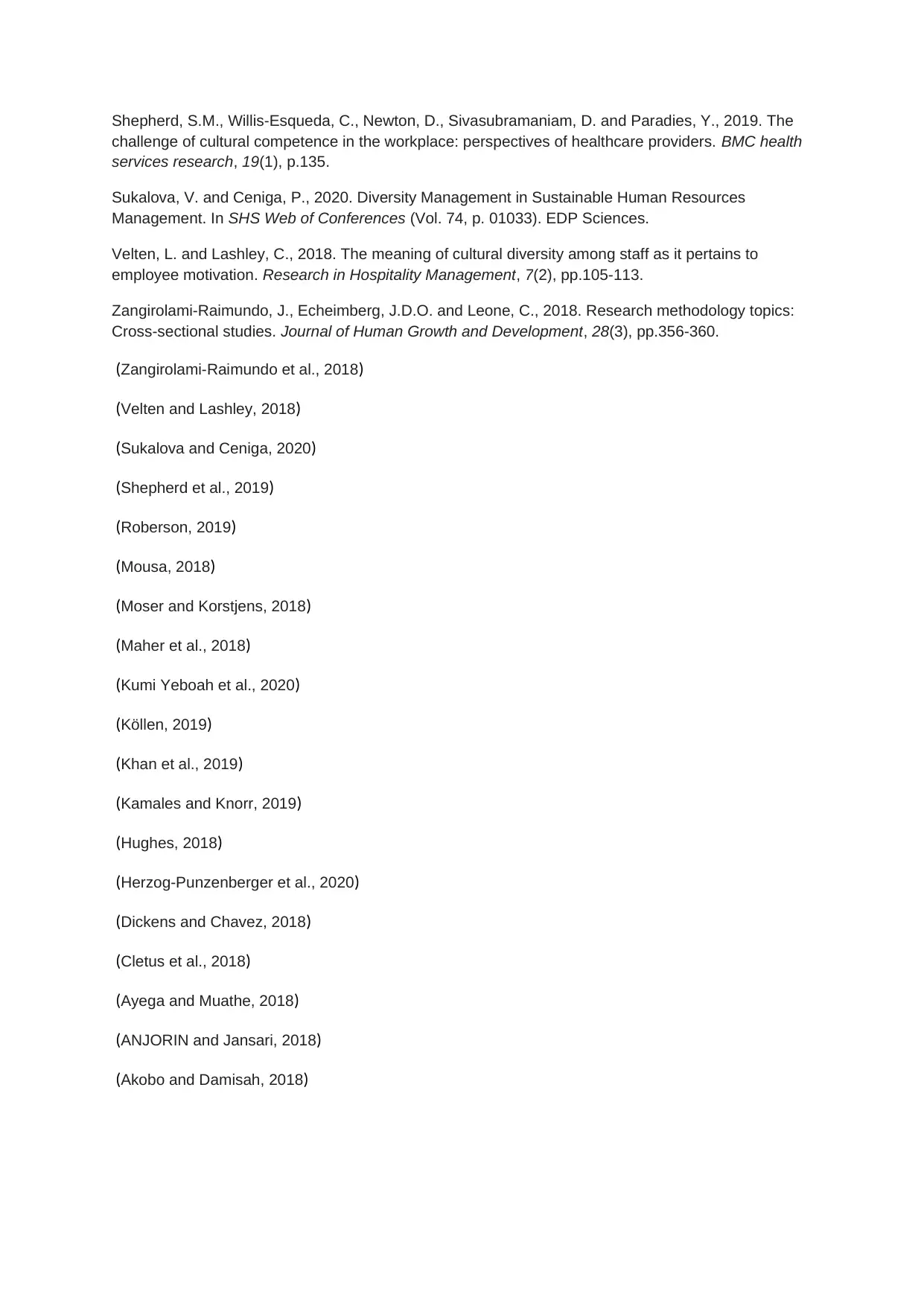
Shepherd, S.M., Willis-Esqueda, C., Newton, D., Sivasubramaniam, D. and Paradies, Y., 2019. The
challenge of cultural competence in the workplace: perspectives of healthcare providers. BMC health
services research, 19(1), p.135.
Sukalova, V. and Ceniga, P., 2020. Diversity Management in Sustainable Human Resources
Management. In SHS Web of Conferences (Vol. 74, p. 01033). EDP Sciences.
Velten, L. and Lashley, C., 2018. The meaning of cultural diversity among staff as it pertains to
employee motivation. Research in Hospitality Management, 7(2), pp.105-113.
Zangirolami-Raimundo, J., Echeimberg, J.D.O. and Leone, C., 2018. Research methodology topics:
Cross-sectional studies. Journal of Human Growth and Development, 28(3), pp.356-360.
(Zangirolami-Raimundo et al., 2018)
(Velten and Lashley, 2018)
(Sukalova and Ceniga, 2020)
(Shepherd et al., 2019)
(Roberson, 2019)
(Mousa, 2018)
(Moser and Korstjens, 2018)
(Maher et al., 2018)
(Kumi Yeboah et al., 2020)
(Köllen, 2019)
(Khan et al., 2019)
(Kamales and Knorr, 2019)
(Hughes, 2018)
(Herzog-Punzenberger et al., 2020)
(Dickens and Chavez, 2018)
(Cletus et al., 2018)
(Ayega and Muathe, 2018)
(ANJORIN and Jansari, 2018)
(Akobo and Damisah, 2018)
challenge of cultural competence in the workplace: perspectives of healthcare providers. BMC health
services research, 19(1), p.135.
Sukalova, V. and Ceniga, P., 2020. Diversity Management in Sustainable Human Resources
Management. In SHS Web of Conferences (Vol. 74, p. 01033). EDP Sciences.
Velten, L. and Lashley, C., 2018. The meaning of cultural diversity among staff as it pertains to
employee motivation. Research in Hospitality Management, 7(2), pp.105-113.
Zangirolami-Raimundo, J., Echeimberg, J.D.O. and Leone, C., 2018. Research methodology topics:
Cross-sectional studies. Journal of Human Growth and Development, 28(3), pp.356-360.
(Zangirolami-Raimundo et al., 2018)
(Velten and Lashley, 2018)
(Sukalova and Ceniga, 2020)
(Shepherd et al., 2019)
(Roberson, 2019)
(Mousa, 2018)
(Moser and Korstjens, 2018)
(Maher et al., 2018)
(Kumi Yeboah et al., 2020)
(Köllen, 2019)
(Khan et al., 2019)
(Kamales and Knorr, 2019)
(Hughes, 2018)
(Herzog-Punzenberger et al., 2020)
(Dickens and Chavez, 2018)
(Cletus et al., 2018)
(Ayega and Muathe, 2018)
(ANJORIN and Jansari, 2018)
(Akobo and Damisah, 2018)
1 out of 8
Related Documents
Your All-in-One AI-Powered Toolkit for Academic Success.
+13062052269
info@desklib.com
Available 24*7 on WhatsApp / Email
![[object Object]](/_next/static/media/star-bottom.7253800d.svg)
Unlock your academic potential
Copyright © 2020–2025 A2Z Services. All Rights Reserved. Developed and managed by ZUCOL.





